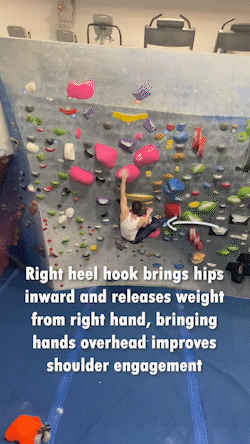Breakdown
Climber: Eddie Pandolfino 6’0”/-2
Wall Angle: 10° Overhang
Holds: Teknik No Shadow Tip Toes, Teknik Gigantiplats, Kilter Winter Kaiju Roof Slopers, Kilter Winter Medium Incut Fins
RIC: Risk 1, Intensity 4, Complexity 4
The objective of this boulder was to create an experience that revolves around shifting body tensions. The slopers throughout the climb lend themselves to high intensity. The climber must maintain high amounts of shoulder and core tension to transfer their weight around them effectively. Complexity is also significant on this climb because of the number of advanced techniques utilized throughout the boulder. There are transitions between positions of extension, compression, and constriction. These reward climbers that have been practicing multiple body positioning skill sets. Additionally, heel hooks and knee bars come into play to prevent any straightforward sequences. Risk is low because the movements can be easily learned and are not insecure.
Influence/Aesthetic:
Most of the inspiration for this boulder came from the perspective of movement. After setting with Chris Rivera (@cs_rivera) the previous week, his ability to set drastically differing box sizes in the same boulder was impressive. I wanted to play on this and set a boulder that uses extension and constriction to engage the climber at different lengths. This distancing between holds reflects this movement style as the climb travels between large clusters of holds, but does not offer any filler in the middle. This offers a clean look with the combination of equidistant spacing and smooth holds. However, I don’t feel that this climb is visually impressive because the hold groupings look incoherent and unintentional.
Hold Selection:
Picking holds for this boulder was a bit of a double-edged sword. While it was obvious that the Gigantiplat slopers could be utilized in a set, they are so old and slick that it is impossible to grab them without jibs. Using screw-ons makes them grabbable but changes their nature to more of a sloping crimp, rather than a pure sloper. The Teknik Tip Toes are a good option to improve slopers specifically because they don’t offer an incut surface, so part of the “integrity” of the sloper is preserved. The remainder of the holds used were placed in a highly directional manner to maintain the theme of tension and compression.
Get Buck
The boulder begins with placing the climber in a position of constriction due to a high right foot.
Bringing their right hand up allows the climber to slightly remove constriction and begin to straighten their leg.
Pulling with the arms lets the hips pivot upward over the right foot and propels the climber upward to the next sloper.
The climber’s left leg extends to create a counterweight beneath the sloper to improve engagement.
The Heel Deal
The climber sets a heel hook to release weight from their right hand. This keeps their hips square as they move their right hand upward to the next sloper.
Hanging low on the slopers improves shoulder engagement and allows the climber to begin removing the heel hook and begin working their feet leftward.
The Bee’s Knees
Swinging a high left foot creates opposition for the climber to begin locking their right arm off.
Gaining the sloper shifts the climber’s weight farther right and knee barring against it increases lock-off distance while simultaneously releasing weight from the left hand.
Once the climber gains the far left-hand crimp, they are unable to continue moving leftward without unlocking their right arm.
Taking the Top
Flipping to the right sidepull creates opposition against the left hand and squares the climber’s body.
The climber can now move their right leg upward and move to gain the finish.
Final Thoughts
Knee bars can be tricky to utilize in a way that promotes forward movement. Usually, the technique has a connotation with route climbing and resting. Gaining a knee bar often puts a climber in a position to take most of the weight off their hands and recover. Generally, this is not the most useful technique to incorporate into a boulder because of its short nature. In this case, the knee bar is not good enough to go no-hands on, but it offers enough assistance to shift weight around without feeling “stuck” in the position. The specific nature of knee bars can make them challenging to set, but they can be a useful technique for climbers to experience and incorporate into their tool belt.




